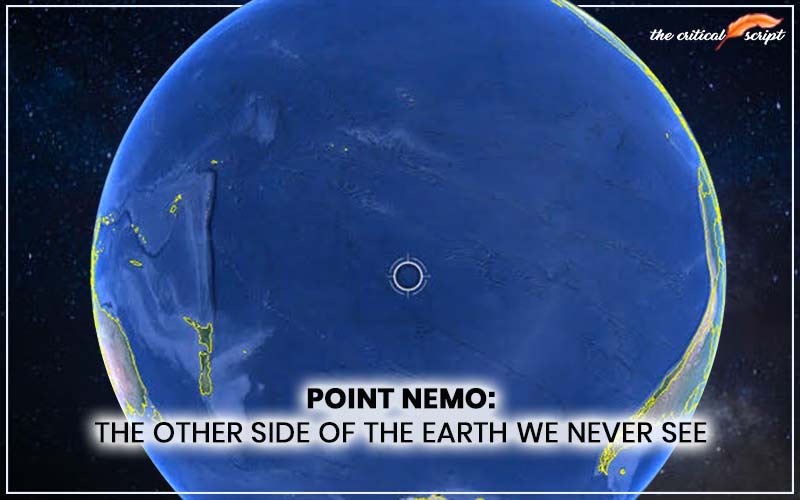
Point Nemo: The Other Side Of The Earth We Never See
Consider this: India spans approximately 2933 km from its easternmost point near Kibithu (97°25' E) in Arunachal Pradesh to its westernmost point, Guhar Moti (68°7' E) in Gujarat. Now, picture this distance in comparison to India and Chile (located on the west coast of South America.) Separated by the Pacific Ocean, Southern Ocean, and South Atlantic Ocean, Chile stands as the farthest country from India, approximately 18,975.97 km (11,826 miles) away.
Now, imagine the furthest remote point from any land on the planet Earth– i.e. Point Nemo.
Point Nemo, also known as the loneliest place on Earth, is situated in the vast abyss of the South Pacific Ocean. It has also been termed the "Oceanic Pole of Inaccessibility'' because of how extremely challenging it is to reach and access the spot. The location was officially identified in 1992 by a Croatian-Canadian survey engineer named Hrvoje Lukatela, using a geo-spatial computer program to calculate the exact point.
This invisible spot is actually not a piece of land, but rather a point furthest from any land in all directions of the planet Earth. It is approximately 2,688km away from the nearest land in all directions, including the Pitcairn Islands, Moto Nui in the Easter Islands, and Maher Island in Antarctica.
The name "Nemo," which comes from the popular submarine sailor Captain Nemo in Jules Verne's "20,000 Leagues Under the Sea" (a story about three men searching for a giant whale at sea), suitably translates to "no man" in Latin, highlighting this place's isolation. Point Nemo is considered so remote that individuals on the nearest land or passing boats may feel the loneliness and distance similar to that experienced by astronauts in space stations, isolated from the bustling activity on Earth.
It is believed to be a dead zone located in the huge, never-ending ocean, in the middle of the ginormous rotating current known as the South Pacific Gyre. Oceanographer Steven D'Hondt even describes it as "the deadest spot in the ocean." And because Point Nemo is so secluded, there isn't much marine life within the location. Given that there aren't enough nutrients in the water, the marine ecosystem has had difficulty evolving, which makes it unsuitable for more developed and evolved species.
This remote location has attracted the interest of scientists, with the mysterious "Bloop" noise being detected less than 1,250 miles east of Point Nemo in the 1990s. This loud sound, initially thought to be made by an unknown sea monster, was later identified as the sound of a giant iceberg cracking and fracturing. Space agencies have a great deal of experience with Point Nemo since they utilise it to determine the re-entry trajectory during the "de-orbiting" procedure. There are rumors that Point Nemo serves as a space junk cemetery, with over 100 decommissioned spacecraft believed to be scattered in the area. This is because it is so far from land and has so little nutrients that it is a perfect area for spacecraft to rest.
For those adventurous enough, it is possible to reach Point Nemo by sailing to the coordinates [45º52.6S, 123º23.6W]. And for those who dare to travel thus far, the longitude, unpredictable conditions, and remoteness present formidable challenges. But be aware that this is a very isolated place with no facilities or goods stores, so guests should be ready for a really lonely experience. This distant ocean location serves as a poignant reminder of the vastness of our planet and the solitude awaiting those who explore beneath its surface. The fact that it didn't even exist until 25 years ago shows just how little we know about our own planet and how much there is still left to discover. The Southern Pole of Inaccessibility in Antarctica and the Eurasian Pole in China are two other hard-to-reach places that one can check out.
In conclusion, Point Nemo is a truly unique and fascinating location on our planet. Its isolation and remoteness make it a place of mystery and intrigue, perfect for scientific exploration and discovery. So next time you're dreaming of an adventure to the most remote place on Earth, remember Point Nemo. It may not have a postcard to send home, but it may offer an experience like no other – a chance to truly disconnect from the rest of the world.
Disclaimer: The opinions expressed in this article are those of the author's. They do not purport to reflect the opinions or views of The Critical Script or its editor.

Newsletter!!!
Subscribe to our weekly Newsletter and stay tuned.















Related Comments